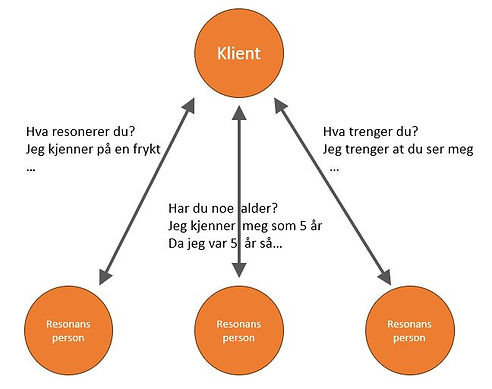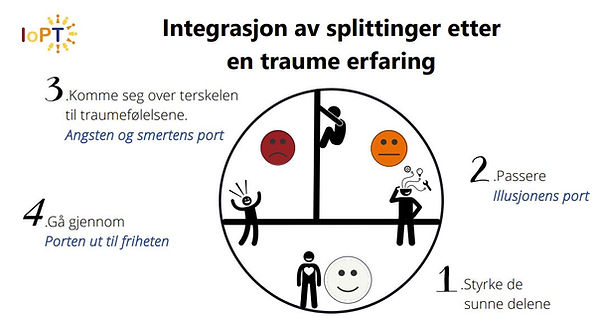The Intention Method
In IoPT (Identity-Oriented Psychotrauma Theory), there is a main method that is used and it is called the Intention Method. We call the execution of the intention method a Self-Encounter. The function of the method is to activate the client's own self-healing abilities. There is no one else but the client himself who can meet and feel his own split-off trauma feelings. It is based on a human sense that we call Resonance in professional language. The intention method is considered a holistic method that processes body and psyche, and is a multi-generational phenomenon that can embrace up to 4 generations with stuck emotions and relationship dynamics. The intention method was developed by Dr. Franz Ruppert, a doctor of psychology and professor of psychology at the University of Applied Sciences in Munich.
The method can be done in a group or one-on-one, both in person and online. Some prefer the former because it is easier to "hide" in the crowd or be in the same boat. Others prefer the latter to avoid exposure.
The intention statement
The client comes to the self-encounter with an intention in the form of a sentence consisting of elements, words and signs. A drawing can also be used as an element if it is better suited to description. The intention statement is what the client wants for themselves for this self-encounter. A sentence can be reused in several self-encounters as issues in the psyche can lie in many layers and must be approached from several angles. A maximum of 3 elements (words/signs/drawing) are chosen from this intention. The intention statement must contain the word "I" and this word MUST also be chosen as one of the elements. A self-encounter without an "I" quickly goes off the rails. The intention is owned solely by the client. It should not be dictated by others. It must come naturally from the client in resonance with themselves. Not even the therapist can comment on or correct the intention statement. It should be as it is designed, even with any spelling errors.
There are no limits to what topic the client may wish to address and formulates the statement of intent accordingly. Examples of statements of intent:
-
I want to understand the pain in my back
-
I want to have a better relationship with my children.
-
I want me
-
I want to stop drinking.
-
I need a partner.
-
I'm afraid of the boss.

Group selfencounter
There are several roles in a group self-encounter:
-
Client: The one who owns the self-encounterand sets the intention. The client is the captain of the ship, the one who decides the journey.
-
Therapist: The one who facilitates self-encounter and creates optimal conditions for the client's self-healing abilities. The therapist is the pilot who knows the dangerous waters.
-
Resonance person: The person who is given the task of mirroring the client's psyche by resonating with the element from the intention statement they are assigned. There are initially a maximum of 3 participating resonance persons in each self-encounter. Additional resonance persons may be included if identification in the client's psyche is suspected.
-
Observer: Those who are not chosen as resonance persons are considered observers and will attend the self-encounter without interference.
The self-encounter is carried out in the following way:
-
The client writes the intention on a board or similar for the entire group to read, and then reads it aloud. In an online self-encounter, the sentence is written in the client's name field or in the chat field.
-
The client then underlines the maximum 3 elements that should be included in the self-encounter. These elements are written individually on notes/post-its. Online, the words are written individually in the chat field.
-
The client then asks selected (by the client himself) people in the group if they want to resonate with the elements. This is done in the form of "Would you like to resonate with the word I?" The person being asked is free to answer yes or no.
-
When the maximum of 3 resonance persons have been selected, they attach the note that represents the element they will resonate on themselves. Online, the element is written in the name field of the resonance person.
-
The client feels in, finds balance within themselves and starts the self-meeting by saying "I am ready."
-
The client gives the resonance persons 1-2 minutes to tune in. The resonance persons move around the therapy room as they feel appropriate. For example, lie down, stand in a corner, seek proximity with the client or other resonance persons, or create distance. This is important information and shows a picture of the interrelationship between the active parts of the client's psyche. It is often a rigid constellation and shows a suboptimal picture of the client's psychological functioning. Each resonance person represents either a healthy part, a survival part, or a trauma part (more about the different parts here )
-
The client then approaches one resonance person at a time in the order of their choice. The resonance persons tell what they are feeling. This can be images, physical symptoms, emotions, etc.
-
The purpose of the dialogue is that the resonance persons reflect memories and experiences that the client has split off and are inaccessible to the client's own consciousness or distorted. The optimal dialogue occurs when it is done in resonance with each other, client and resonance person share with each other by feeling. It should preferably not be a thought-driven interview. This gives the client room to acknowledge and make emotional contact with what has been hidden and through it become better acquainted with their true Self, their own pain, and their survival patterns and life illusions.

-
In the client's dialogue with the resonant persons, movement is created in the rigid and suboptimal starting point. Improve the relationship between the parts, free them from survival tasks, free them from carrying emotions, see them, acknowledge them so they can be transformed into healthy parts.
-
The therapist's task is to support the client. Help interpret what is happening if the client finds it confusing, help the client move forward if they are stuck, and suggest sentences the client can say to their parts to create contact and clarity about reality.

-
The client decides when to end the self-encounter. This may be because:
-
the client has had enough
-
the client is in a good place and is happy with what they have achieved
-
the resonance people have nothing new to share and the self-meeting loses momentum
-
The duration of a self-encounter should not exceed 90-100 minutes, but usually lasts over 60 minutes.
-
The client releases the resonance persons by approaching each one and saying, “Thank you for resonating I, now you are Thomas again.” The resonance person then takes off the note and gives it to the client. Online, the name field from the intention element is changed back to the resonance person’s real name.
-
Then, the resonant persons can share if there is anything else they are holding onto if the client wants to open up about it.
-
The whole thing is rounded off by "closing" the self-meeting. The experience is then allowed to work undisturbed in the client and the content of the self-meeting is then not discussed any further.
-
In the days afterwards (the integration phase), the client may feel physical and emotional reactions. Some people place the notes with the intention elements from the resonant persons in a visible place to keep the experience in consciousness. It is not recommended that the client tell friends and loved ones about the self-encounter, or act on the new knowledge that has come up before it has all landed where it should. The client can always contact a therapist for help and support.
One-on-one self-encounter
-
One-on-one self-encounter is conducted according to the same template as group self-encounter, but with some distinct differences:
-
Client resonates with the intention elements themselves
-
In physical presence, one's own markers can be used to represent the elements (gender, orientation, distance between the elements, location in the room). This is to recreate the same rigid and suboptimal image of the client's psyche, corresponding to the starting point in a group self-meeting. Online, the client can optionally find objects in the room as markers. Standing on/holding the markers can help the client resonate with their own intention elements.
-
In a one-on-one self-encounter, the therapist is often more active and in dialogue with the client. The therapist may also resonate with an element of intention for a short time if appropriate.



